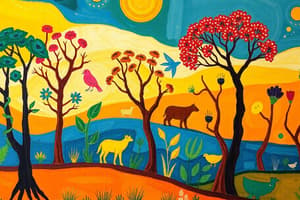Podcast
Questions and Answers
Water is an abiotic factor in an ecosystem.
Water is an abiotic factor in an ecosystem.
True (A)
Predators eat only plant material.
Predators eat only plant material.
False (B)
Chlorophyll traps energy from plants.
Chlorophyll traps energy from plants.
False (B)
An ecosystem contains only living parts.
An ecosystem contains only living parts.
Which of the following does NOT result in fewer species?
Which of the following does NOT result in fewer species?
Which of the following is NOT part of the carbon-oxygen cycle?
Which of the following is NOT part of the carbon-oxygen cycle?
How is nitrogen changed into a form that plants can use?
How is nitrogen changed into a form that plants can use?
A relationship in which an organism is harmed is called?
A relationship in which an organism is harmed is called?
What level in an energy pyramid contains the most available energy?
What level in an energy pyramid contains the most available energy?
Which of the following is least likely to be affected if a tree is cut down?
Which of the following is least likely to be affected if a tree is cut down?
What might be three adaptations of a prey animal that help it escape from its predators?
What might be three adaptations of a prey animal that help it escape from its predators?
How might your local environment be affected by the building of a dam?
How might your local environment be affected by the building of a dam?
What might happen over thousands of years if the climate in a large tropical ecosystem got cold and snowy?
What might happen over thousands of years if the climate in a large tropical ecosystem got cold and snowy?
Flashcards are hidden until you start studying
Study Notes
Ecosystems and Interactions
- Ecosystems are made up of living (biotic) and nonliving (abiotic) parts.
- Abiotic factors like water, carbon dioxide, oxygen, and nitrogen cycle through an ecosystem.
- Biotic factors include producers, consumers, and decomposers.
- Producers are organisms that make their own food using sunlight, like plants.
- Consumers get energy by eating other organisms.
- Decomposers break down dead organisms and waste, recycling nutrients back into the ecosystem.
- Food chains and webs show how matter and energy flow through an ecosystem.
- Energy pyramids show that the amount of available energy decreases at each level of the food chain.
- Predators are consumers that hunt and kill other animals for food.
- Prey are the animals that are hunted and killed by predators.
Interactions Within Ecosystems
- Mutualism: When both organisms benefit from an interaction.
- Commensalism: When one organism benefits, and the other is neither harmed nor helped.
- Parasitism: When one organism benefits at the expense of another.
- Competition: When organisms vie for the same limited resources, like food, water, or shelter.
Carbon-Oxygen Cycle
- Photosynthesis: Plants use sunlight to convert carbon dioxide and water into sugars and oxygen.
- Respiration: Organisms use oxygen to break down sugars and release energy, producing carbon dioxide as a waste product.
Nitrogen Cycle
- Nitrogen-fixing bacteria convert atmospheric nitrogen into a form that plants can use.
- Decomposers release nitrogen back into the soil.
Impact of Human Activities on Ecosystems
- Pollution: Can harm organisms and disrupt ecosystem processes.
- Climate change: Can lead to habitat loss and species extinction.
- Deforestation: Can disrupt ecosystems and reduce biodiversity.
- Overfishing: Can deplete fish populations and damage marine ecosystems.
Adaptations for Survival
- Camouflage: Blending in with the surroundings to avoid predators.
- Speed: Running faster than predators.
- Defense Mechanisms: Venomous bites, sharp claws, etc.
Importance of Biodiversity
- A diverse ecosystem is more resilient to change and better able to adapt to environmental challenges.
- Loss of biodiversity can have negative consequences for the entire ecosystem.
Studying That Suits You
Use AI to generate personalized quizzes and flashcards to suit your learning preferences.




